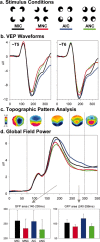Setting boundaries: brain dynamics of modal and amodal illusory shape completion in humans
- PMID: 15295024
- PMCID: PMC6729598
- DOI: 10.1523/JNEUROSCI.1996-04.2004
Setting boundaries: brain dynamics of modal and amodal illusory shape completion in humans
Abstract
Normal visual perception requires differentiating foreground from background objects. Differences in physical attributes sometimes determine this relationship. Often such differences must instead be inferred, as when two objects or their parts have the same luminance. Modal completion refers to such perceptual "filling-in" of object borders that are accompanied by concurrent brightness enhancement, in turn termed illusory contours (ICs). Amodal completion is filling-in without concurrent brightness enhancement. Presently there are controversies regarding whether both completion processes use a common neural mechanism and whether perceptual filling-in is a bottom-up, feedforward process initiating at the lowest levels of the cortical visual pathway or commences at higher-tier regions. We previously examined modal completion (Murray et al., 2002) and provided evidence that the earliest modal IC sensitivity occurs within higher-tier object recognition areas of the lateral occipital complex (LOC). We further proposed that previous observations of IC sensitivity in lower-tier regions likely reflect feedback modulation from the LOC. The present study tested these proposals, examining the commonality between modal and amodal completion mechanisms with high-density electrical mapping, spatiotemporal topographic analyses, and the local autoregressive average distributed linear inverse source estimation. A common initial mechanism for both types of completion processes (140 msec) that manifested as a modulation in response strength within higher-tier visual areas, including the LOC and parietal structures, is demonstrated, whereas differential mechanisms were evident only at a subsequent time period (240 msec), with amodal completion relying on continued strong responses in these structures.
Figures


Similar articles
-
The spatiotemporal dynamics of illusory contour processing: combined high-density electrical mapping, source analysis, and functional magnetic resonance imaging.J Neurosci. 2002 Jun 15;22(12):5055-73. doi: 10.1523/JNEUROSCI.22-12-05055.2002. J Neurosci. 2002. PMID: 12077201 Free PMC article.
-
Brain mechanisms for perceiving illusory lines in humans.Neuroimage. 2018 Nov 1;181:182-189. doi: 10.1016/j.neuroimage.2018.07.017. Epub 2018 Jul 7. Neuroimage. 2018. PMID: 30008430
-
The effect of interpolation and perceptual difficulty on the visual potentials evoked by illusory figures.Brain Res. 2006 Jan 12;1068(1):143-50. doi: 10.1016/j.brainres.2005.10.064. Epub 2005 Dec 22. Brain Res. 2006. PMID: 16376314 Clinical Trial.
-
Illusory contours: a window onto the neurophysiology of constructing perception.Trends Cogn Sci. 2013 Sep;17(9):471-81. doi: 10.1016/j.tics.2013.07.004. Epub 2013 Aug 6. Trends Cogn Sci. 2013. PMID: 23928336 Review.
-
What, if anything, can be considered an amodal sensory dimension?Psychon Bull Rev. 2024 Oct;31(5):1915-1933. doi: 10.3758/s13423-023-02447-3. Epub 2024 Feb 21. Psychon Bull Rev. 2024. PMID: 38381301 Free PMC article. Review.
Cited by
-
Late, not early, stages of Kanizsa shape perception are compromised in schizophrenia.Neuropsychologia. 2014 Apr;56:302-11. doi: 10.1016/j.neuropsychologia.2014.02.001. Epub 2014 Feb 8. Neuropsychologia. 2014. PMID: 24513023 Free PMC article.
-
Cue-invariant networks for figure and background processing in human visual cortex.J Neurosci. 2006 Nov 8;26(45):11695-708. doi: 10.1523/JNEUROSCI.2741-06.2006. J Neurosci. 2006. PMID: 17093091 Free PMC article.
-
Decoding information about dynamically occluded objects in visual cortex.Neuroimage. 2017 Feb 1;146:778-788. doi: 10.1016/j.neuroimage.2016.09.024. Epub 2016 Sep 20. Neuroimage. 2017. PMID: 27663987 Free PMC article.
-
The Importance of Amodal Completion in Everyday Perception.Iperception. 2018 Jul 31;9(4):2041669518788887. doi: 10.1177/2041669518788887. eCollection 2018 Jul-Aug. Iperception. 2018. PMID: 30109014 Free PMC article.
-
Can Contrast-Response Functions Indicate Visual Processing Levels?Vision (Basel). 2018 Mar 1;2(1):14. doi: 10.3390/vision2010014. Vision (Basel). 2018. PMID: 31735878 Free PMC article.
References
-
- Caputo G, Romani A, Callieco R, Gaspari D, Cosi V (1999) Amodal completion in texture visual evoked potentials. Vision Res 39: 31-38. - PubMed
-
- Corballis PM, Fendrich R, Shapley RM, Gazzaniga MS (1999) Illusory contour perception and amodal boundary completion: evidence of a dissociation following callosotomy. J Cognit Neurosci 11: 459-466. - PubMed
-
- De Weerd P, Desimone R, Ungerleider LG (1996) Cue-dependent deficits in grating orientation discrimination after V4 lesions in macaques. Vis Neurosci 13: 529-538. - PubMed
-
- Doniger GM, Foxe JJ, Schroeder CE, Murray MM, Higgins BA, Javitt DC (2001) Visual perceptual learning in human object recognition areas: a repetition priming study using high-density electrical mapping. NeuroImage 13: 305-313. - PubMed
Publication types
MeSH terms
Grants and funding
LinkOut - more resources
Full Text Sources
